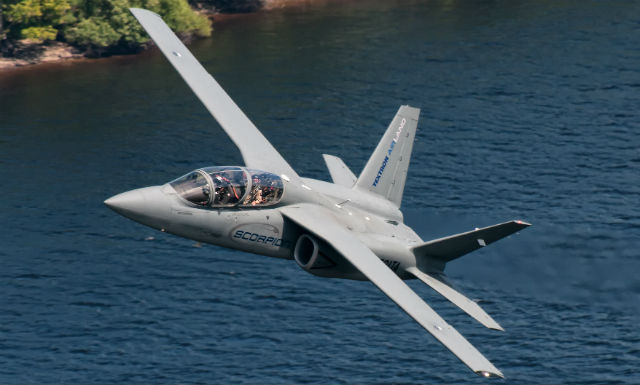When commercial aircraft product launches are stage-managed with a careful unveiling of billions of dollars worth of orders from a few hand-picked customers, the sight of a new military aircraft propelled into development with no announced buyers can come across as a rarity bordering on reckless.
Selling military aircraft is already a hard business, subject to feckless stewards in the acquisition offices, unreliable support in the political class and shifting requirements from an, often exclusive, primary customer. But at least the development cost is usually paid by the taxpayer, freeing the contractor from the risk of a wholly profitless venture. Remove that development subsidy and the whole business looks unfriendly to all but high-stakes gamblers.
Into this marketing maelstrom in 2013 was thrown the Textron AirLand Scorpion, a twin-engined fighter with three plausible military missions: intelligence, surveillance and reconnaissance; light attack; and advanced jet training.

Textron AirLand
Three years into the project, the Scorpion demonstrator has yet to find a launch customer. It is not the world’s only self-funded development project. In South Africa, Paramount is developing the turboprop-powered AHRLAC for a similar role, with perhaps even dimmer prospects of a launch order on the way from the cash-strapped government in Pretoria.
Historically, for every visionary gamble – Abe Karem’s unmanned Predator comes to mind – there are many more expensive flops, such as the worthy-yet-unloved Northrop F-20 fighter. In which basket will the Scorpion ultimately fall? A production-conforming prototype, possibly ready in time for the Farnborough air show, will no doubt soon settle the matter.
Textron AirLand’s sales pitch is at least timely and truthful. Where modern fighters carry awesome sensors and weapons at eye-watering prices, the Scorpion offers similar capabilities and even a trainer on a comparatively cheap platform, albeit one that can only operate with minimal risk of attack from ground or air.
Maybe Textron AirLand need not even make a sale to deem the Scorpion a success. Assembling the airframe has given joint venture partner Textron Aviation hands-on experience in all-composite jets, which may one day boost its Cessna and Beechcraft ranges.
But Textron AirLand is a determined champion. At Farnborough and other events later this year, Scorpion will receive a fair hearing – and let the chips in this high-stakes game fall where they may.
Source: Flight International





























